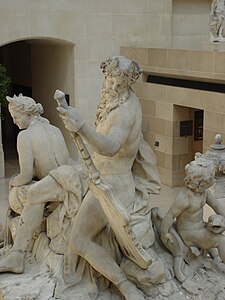Corneille Van Clève
Corneille Van Clève | |
|---|---|
 Portrait of Clève from 1701 by Académie member Pierre Gobert | |
| Born | |
| Baptised | 10 June 1646 |
| Died | 31 December 1732 (aged 86) Paris, Kingdom of France |
| Education | François Anguier |
| Known for | Sculpture |
| Spouse | Marie-Antoinette De Meaux de Vallicre |
| Children | Josse Van Clève |
| Awards | Prix de Rome (1671) |
| Patron(s) | Louis XIV, Louis XV |
| Director of the Académie de Peinture et de Sculpture | |
| In office 1711–1714 | |
| Monarch | Louis XIV |
| Preceded by | François de Troy |
| Succeeded by | Antoine Coypel |
Corneille Van Clève (bapt. 10 June 1646 – 31 December 1735) was a French sculptor.
Biography
Clève was born in Paris in 1646 to a family of Flemish goldsmiths and baptized on 10 June that year. His grandfather, a merchant goldsmith, immigrated to Paris from Flanders and was naturalized by King Henry IV in 1606.[1] Cleve studied under French sculptor François Anguier and received the Prix de Rome scholarship in 1671.[2]
After spending several years there at the French Academy in Rome, as well as three years in Venice, Clève returned to France in 1678.[3] On 26 April 1681, he was formally accepted to the Académie de Peinture et de Sculpture upon submission of a marble statue of the cyclops Polyphemus.[4] Clève would be director of the Académie from 1711 to 1714.[5] Clève enjoyed the patronage of both King Louis XIV and Louis XV, earning the King's pension until his death and sculpting numerous statues for the Palace at Versailles.[1]
Clève married Marie-Antoinette De Meaux de Vallicre, half-sister of the famous goldsmith Nicolas de Launay, on 31 January 1682. She died in May 1683, just a few days after giving birth to their only son, Josse. He went on to become a sculptor, working in his father's workshop and earning several awards from the Académie, but would die on 4 June 1711.[1]
Clève died during the night of 30-31 December 1732 following a long bout of illness that begun in April 1730.[1]
Selected works
- Polyphemus (1680-81) – The Louvre, Paris
- Work at Versailles Palace (1681-82) – Worked on the apartment of the Prince de Conti on the ground floor of the South Wing.
- Cleopatra or Sleeping Ariadne (1684-86) – Gardens of Versailles, Versailles
- Lion crushing a Wolf (1685-87) – Gardens of Versailles, Versailles
- Mercury (1685-87) – Gardens of Versailles, Versailles
- Cleopatra (1665-1700) – The Louvre, Paris
- Leda and the Swan (1685-1700) – The Louvre, Paris
- The Rivers Loire and Loiret (1699-1707) – The Louvre, Paris
- Psyche and Cupid (1700-1710) – National Museum of Western Art, Tokyo
- Venus and Cupid (1700-1710) – National Museum of Western Art, Tokyo
- Bacchus and Ariadne (1704 or before) – Exhibited at the Salon of 1704; Legion of Honor, San Francisco
- Sanctuary and High Altar (1709-10) – Chapel of Versailles, Versailles
Gallery (partial)
- Works by Corneille Van Clève
-
Polyphemus (1681)
-
The Rivers Loire and Loiret (1699-1707)
-
Psyche and Cupid (1700-1710)
-
Venus and Cupid (1700-1710)
References
- ^ ISBN 0-85181-053-5.
- ^ Benezit Dictionary of Artists. Vol. 3, Bulow–Cossin. Paris: Éditions Gründ. 2006. p. 1123.
- ISBN 0-300-05344-4.
- ^ "Polyphème assis sur son rocher". collections.louvre.fr (in French). 13 October 2022. Retrieved 21 July 2023.
- ISBN 978-1-4094-5742-8.




